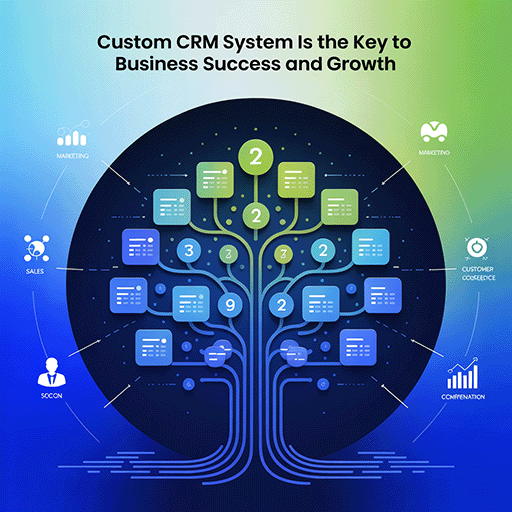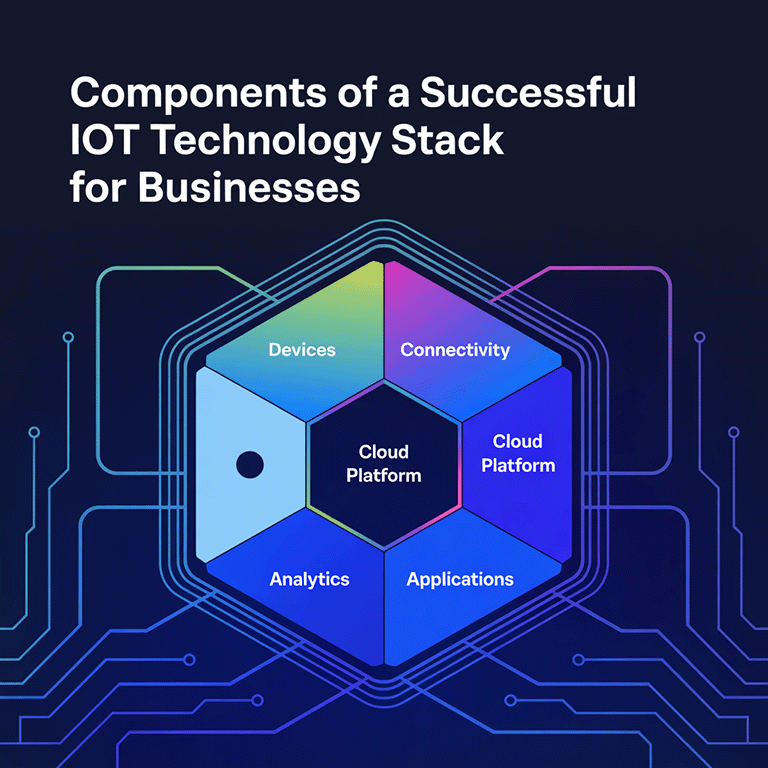ChatGPT by OpenAI is a revolutionary AI tool that changes how users interact with apps. It transformed personal productivity apps and customer service bots with its language model. Knowing how to integrate ChatGPT into an app lets you create real-time, human-like interactions. ChatGPT became the fastest-growing consumer app, gaining over 100 million users in just two months after its launch.
For both technical teams and product leaders, this guide provides a step-by-step method on how to integrate ChatGPT into an app. Use cases, business advantages, implementation techniques, and expectations for development effort, cost, and outcomes will all be covered.
Why Integrating ChatGPT is a Game-Changer
The expectations of users are changing. Users of apps today desire quick, easy, and interactive experiences. Smart, responsive systems that comprehend intent, deliver pertinent information, and automate tasks are replacing conventional menus and static interfaces.
You can provide intelligent features without creating a whole NLP engine from scratch by integrating ChatGPT into your web or mobile application. ChatGPT integrations make it possible to provide these features with little complexity, whether you’re a customer service chatbot that responds to user enquiries instantly, a content creation tool that produces copy in a matter of seconds, or a personal coach that offers detailed instructions. The outcome? Reduced support expenses, happier customers, and noticeably higher product engagement.
In our review of ChatGPT’s primary features, we go into greater detail about this, including the speed and accuracy gains made with GPT-4.
Benefits of Integrating ChatGPT in a Mobile App
An intelligent, intuitive, and customised experience is produced when ChatGPT is integrated into a mobile application. ChatGPT allows for dynamic, conversational interactions that instantly adjust to the needs of the user, in contrast to static interfaces or rule-based bots. This not only enhances user interaction with your app but also lowers support expenses, expedites onboarding, and opens up new revenue streams. Companies can stand out in a crowded app market, improve customer satisfaction, and boost retention.
Here are some of the key benefits:
Improved user interaction through natural, real-time conversations
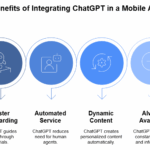
- Faster onboarding with AI-guided walkthroughs and tutorials
- Automated customer service minimizes the reliance on human assistance
- Dynamic content generation for messaging, recommendations, or personalization
- 24/7 availability, ensuring users get help or information anytime they need it
Higher user satisfaction and retention, leading to long-term app growth
ChatGPT can greatly increase the value of your mobile app by providing intelligent, conversational features that turn it from merely functional to genuinely interactive.
Where ChatGPT Adds the Most Value
Despite ChatGPT’s wide range of applications, a few stand out as being especially beneficial for increasing engagement. It can automatically respond to commonly asked questions in customer service, offer guidance on troubleshooting, and refer problems to the appropriate human agent when necessary. In addition to lowering operating expenses, this improves user experience by offering prompt responses.
ChatGPT integrations can be used to generate or suggest content in real time in applications that rely heavily on content, like media apps, e-commerce platforms, and writing tools. You can provide users with dynamically generated ideas, headlines, or product descriptions based on their inputs and preferences rather than depending only on templates or static suggestions.
Another fascinating area is virtual assistant capabilities. AI is being used more and more in productivity, education, travel, and fitness apps to offer individualised, conversational experiences. ChatGPT facilitates interactions that are adaptive and feel natural, which keeps users interested and increases the likelihood that they will return.
Read our article on GPT-4 Turbo and Vision capabilities to learn more about what the newest GPT model can do.
How to Integrate ChatGPT into Your App: A Step-by-Step Breakdown
From concept to implementation, ChatGPT integrations into your product require several distinct steps. The basic workflow is the same, even though it might change a little based on your stack and objectives.
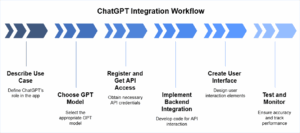
Here is a brief explanation of the integration procedure:
1. Describe the Use Case for ChatGPT
Give a detailed description of ChatGPT’s functions in your app, such as customer service, content creation, onboarding support, etc.
2. Choose the GPT Model
Depending on your needs for complexity, latency, and cost, pick between GPT-3.5, GPT-4, or GPT-4 Turbo.
3. Register and Get API Access
Create an account on OpenAI’s platform, generate an API key, and go over their usage guidelines.
4. Put Backend Integration into Practice
Create code to handle the AI’s responses and send user inputs to the ChatGPT API. This covers the configuration of API calls and prompt engineering.
5. Create the User Interface
Choose whether users will communicate with ChatGPT by text, voice, or chat. Cleanly incorporate answers into your user interface.
6. Test and Monitor
To guarantee response accuracy, manage edge cases, and track token usage and performance over time, conduct comprehensive quality assurance.
Do you require practical assistance? The AI integration team at LITSLINK uses scalable architecture, dependable code, and user-friendly design to deliver comprehensive Artificial Intelligence services, assisting you from concept to deployment.
Android Integration: Considerations and Strategy
How to use AI in a mobile app? There are certain mobile-specific tasks involved in integrating ChatGPT if you’re developing for Android. Once the integration points have been established, you will usually use Retrofit or OkHttp to make API requests from your application. To make it comfortable for users to type or converse with the assistant, the interface should be optimised for mobile devices.
Asynchronous programming using threads (in Java) or coroutines (in Kotlin) is used to guarantee performance and avoid UI freezing. To control latency and enhance user experience, you’ll also need to cache or store API responses in memory. Using Jetpack Compose to create a clear, responsive user interface contributes to providing the smooth experience that users anticipate.
Beyond the Code: Business Value of ChatGPT Features
Although technical integration is important, ChatGPT’s value addition to your product is what pays off. Conversion rates, session duration, and retention can all be considerably raised by AI-enhanced features. When an app can respond to their queries, finish tasks for them, or come up with ideas instantly, for instance, users are more likely to use it again.
Presenting your app as “AI-powered” increases its competitive appeal from a marketing perspective. Personalised suggestions and intelligent messaging are two examples of features that set your app apart and draw in users who demand cutting-edge, user-friendly interfaces.
ChatGPT can also power premium features in subscription-based apps, like AI-based coaching, intelligent scheduling, and long-form content creation, opening up new revenue streams.
What Does ChatGPT Integration Cost?
The complexity of your app, the number of features it has, the infrastructure it needs, and post-launch support all affect how much it costs to integrate, depending on the model and usage volume.
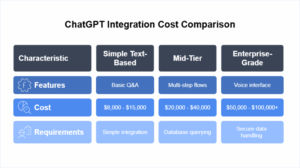
The integration process is comparatively simple for apps that only need simple text-based Q&A features, like customer support bots or basic content helpers. Depending on the platform (iOS, Android, or web) and UI requirements, development for this kind of feature usually costs between $8,000 and $15,000.
The price goes up if your app needs more sophisticated features, like multi-step flows, database querying, custom user prompts, or context retention. When more logic and integrations are required to manage user data, roles, or stateful interactions, mid-tier ChatGPT implementations typically cost between $20,000 and $40,000.
Higher-end enterprise-grade ChatGPT integrations can cost $50,000 to $100,000+ and feature voice interface capabilities, multiple user access levels, and secure data handling across sizable user bases. Extensive backend customisation, ongoing prompt engineering improvement, and performance and compliance-focused DevOps are usually required for these solutions.
For a clear and quick estimate, reach out to us directly. We’ll help calculate the ChatGPT integration cost based on your goals and scope.
Security and Privacy in ChatGPT Apps
Applications of AI are strong, but they need to be safe. Think about how user inputs and responses are saved, whether sensitive information is included in prompts, and how your system handles mistakes or abusive queries when integrating ChatGPT.
Regulatory compliance (such as GDPR or HIPAA) becomes crucial for sectors like healthcare, finance, and education. To maintain privacy and control in these situations, it might be required to use local inference tools or host a private version of GPT.
Let’s Build Your AI-Driven App Together
ChatGPT is a revolutionary change in the way people use digital products, not just a cool feature. It changes the dynamic from passive interfaces to conversational, intelligent systems that can comprehend emotion, context, and intent. ChatGPT integrations enable apps to deliver experiences that feel responsive, natural, and even human-like, moving beyond static menus and inflexible workflows.
With features like intelligent prompts to help with content creation, personalised recommendations based on user behaviour, and the ability to comprehend plain-language queries to simplify navigation, ChatGPT adds a level of interactivity that was previously difficult to accomplish without a significant amount of development work. In addition to convenience, users experience genuine engagement as a result, feeling heard, helped, and more likely to come back.
But adding ChatGPT to an app isn’t a simple fix. It takes careful planning to determine the areas in which AI is most useful, scalable, and clean code to implement the API efficiently, and ongoing optimisation to gradually improve accuracy and fine-tune prompts. Clear use cases, careful design, and a thorough comprehension of both technical architecture and user requirements are essential for success.
However, there is a substantial reward for doing it correctly. You receive a more intelligent, interactive, and future-ready application that not only serves users but also changes with them. Integrating ChatGPT could be the upgrade that makes your product stand out in a market where loyalty is defined by experience.


